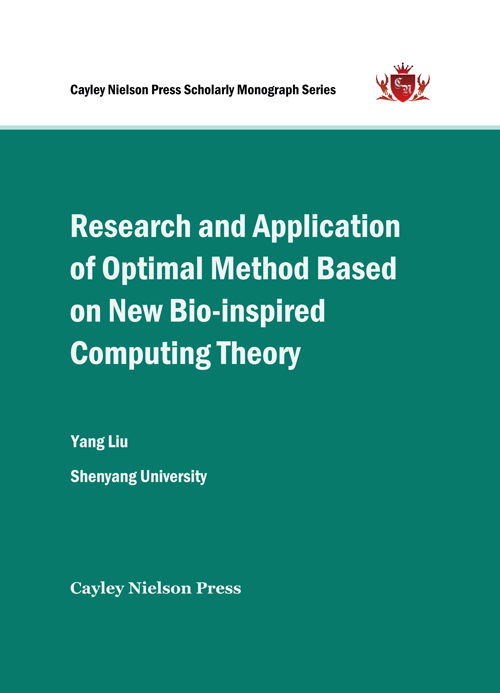
RESEARCH AND APPLICATION OF OPTIMAL METHOD BASED ON NEW BIO-INSPIRED COMPUTING THEORY

Yang Liu
Shenyang University
Copyright © 2017 by Cayley Nielson Press, Inc.
ISBN: 978-0-692-85779-3
Cayley Nielson Press Scholarly Monograph Series Book Code No.: 129-7-4
US$85.00
Preface
In the field of computational intelligence, behavioural characteristics and evolution characteristics of biological certain individuals or groups give researchers a lot of inspiration, a lot of optimization algorithm which simulate biological behaviour and phenomenon emerged, all these above studies referred to as bio-heuristic calculation method. Although heuristic computing research based on biological foraging behavior more and more matures, by analyzing the existing work can be seen that in the process to solve complex practical problems, how to implement the algorithm diversity preservation strategy, taking into account the balance of global and local search strategies and adaptive algorithm parameter optimization strategy, overcome premature convergence, improve search efficiency and convergence precision, all above aspect still have large room for improvement..........
Contents
Preface........................................................................................................................................... I
1 Hybrid Artificial Root Foraging Optimizer Based Multilevel Threshold for Image Segmentation 1
1.1 Introduction...................................................................................................................... 1
1.2 Hybrid Artificial Root Foraging Optimizer.................................................... 3
1.2.1 Artificial Root Foraging Model (ARFO)....................................................... 3
1.2.1.1 Auxin Regulation.................................................................................................... 4
1.2.1.2 Main Roots Growth: Regrowing and Branching................................ 5
1.2.1.3 Lateral Roots Growth: Random Walking............................................... 7
1.2.1.4 Dead Roots Growth: Shrinkage.................................................................... 7
1.2.2 Root-to-root Communication............................................................................. 9
1.2.3 Co-evolution mechanism................................................................................... 11
1.2.4 The Proposed Algorithm................................................................................... 13
1.3 Benchmark Test.......................................................................................................... 13
1.3.1 Test Functions.......................................................................................................... 13
1.3.2 Experimental Configure..................................................................................... 15
1.3.3 Parameters Sensitivity......................................................................................... 19
1.3.4 Computational Results........................................................................................ 21
1.3.5 Timing Complexity Analysis............................................................................. 25
1.4 Real-world Application for Image Segmentation................................... 26
1.4.1 Otsu Criterion............................................................................................................ 26
1.4.2 Experiment Setup................................................................................................... 27
1.4.3 Experimental Results and Analysis............................................................. 29
1.5 Conclusions.................................................................................................................... 34
1.6 Acknowledgements................................................................................................... 35
2 Dynamic Population Artificial Bee Colony Algorithm for Multi-objective Optimal Power Flow 36
2.1 Introdution..................................................................................................................... 36
2.2 The Original Artificial Bee Colony Algorithm........................................... 39
2.3 The Dynamic Population ABC Algorithm with Life-Cycle Model. 43
2.4 The Optimal Problem Formulation................................................................. 47
2.5 Results............................................................................................................................... 51
2.6 Conclusion....................................................................................................................... 56
2.7 Acknowledgements:.................................................................................................. 56
3 Image Segmentation Using Artificial Intelligence Approaches.......... 57
3.1 Image Segmentation................................................................................................. 57
3.2 Pulse Coupled Neural Network (PCNN)...................................................... 58
3.3 Particle Swarm Optimization (PSO)................................................................ 60
3.4 PCNN and PSO based Image Segmentation Algorithm (PCNN-PSO) 61
3.5 Experiment Result...................................................................................................... 65
3.6 Acknowledgment........................................................................................................ 66
4 An Improved Clustering Method to Evaluate Teaching based on ABC -FCM 67
4.1 Introduction................................................................................................................... 67
4.2 FCM Alorithm................................................................................................................ 68
4.3 Arificial Bee Colony Bee Colony Algrothim............................................... 70
4.4 Improvement FCM Clustering Algorithm Based on ABC.................. 71
4.5 Experimental Results............................................................................................... 74
4.5.1 The result of ABC-FCM algorithms............................................................. 74
4.5.2 The result of Teaching Evaluation.............................................................. 75
4.6 Conclusion....................................................................................................................... 77
4.7 Acknowlegment........................................................................................................... 78
5 A novel method for image segmentation based on Nature Inspired Algorithm 79
5.1 Introduction................................................................................................................... 79
5.2 Image thresholding................................................................................................... 80
5.3. Image segmentation algorithm based on Hybrid Particle Swarm Optimization (HPSO) 82
5.3.1 Traditional Particle Swarm Optimization (PSO)................................. 82
5.3.2 Hybrid Particle Swarm Optimization (HPSO)....................................... 84
3.3 Image segmentation algorithm based on HPSO...................................... 85
5.4. Experiment Result..................................................................................................... 87
5.5 Conclusion....................................................................................................................... 93
5.6 Acknowledgment........................................................................................................ 93
6 Color Image Segmentation Using Multilevel Thresho- -lding Hybrid Particle Swarm Optimization 95
6.1 Introduction................................................................................................................... 95
6.2 Color Image segmentation.................................................................................... 96
6.2.1 Conversion of color space................................................................................ 96
6.2.2 The multilevel-threshold................................................................................... 97
6.3 Color image Multi-threshold segmentation based on HPSO........... 98
6.3.1 The Traditional Particle Swarm Optimization...................................... 99
6.3.2 Hybrid Particle Swarm Optimization (HPSO)....................................... 99
6.3.3 Color image Multi-threshold segmentation based on HPSO.... 100
6.4 Experiment Result................................................................................................... 102
6.5 Conclusion.................................................................................................................... 104
6.6 Acknowledgment..................................................................................................... 104
7. An Enhanced Kernel Fuzzy C-Means Based on Bio- inspired Computing Method 105
7.1 Introduction................................................................................................................ 105
7.2 KFCM Algorithm....................................................................................................... 105
7.3 THE Enhanced KFCM Algorithm Based on Artificial Bee Conlony Algorithm 107
7.3.1 The Traditional Artificial Bee Colony Algorithm............................. 107
7.3.2 The enhanced kernel fuzzy C-Means based on ABC..................... 107
7.4 Experiment Results................................................................................................ 109
7.5 Conclusion.................................................................................................................... 111
7.6 Acknowledgment..................................................................................................... 113
8. Color Image Segmentation using Multilevel thresho- -lding-Cooperative Bacterial Foraging Algorithm..................................................................................................................................................... 114
8.1 Introduction................................................................................................................ 114
8.2 Color Image segmentation................................................................................. 115
8.2.1 The conversion of color space................................................................... 115
8.2.2 Multi-level thresholding for image segmentation........................... 115
8.3 Modified bacterial foraging algorithm....................................................... 117
8.3.1 The traditional bacterial foraging algorithm (BFA)...................... 117
8.3.2 Modified bacterial foraging algorithm................................................... 118
8.4 Color Image segmentation algorithm based on multilevel thresholding-CBFA 120
8.5 Experiment Result................................................................................................... 124
8.6 Conclusion.................................................................................................................... 128
8.7 Acknowledgment..................................................................................................... 128
References............................................................................................................................ 130
Readership
This book should be useful for students, scientists, engineers and professionals working in the areas of optoelectronic packaging, photonic devices, semiconductor technology, materials science, polymer science, electrical and electronics engineering. This book could be used for one semester course on adhesives for photonics packaging designed for both undergraduate and graduate engineering students.
